8.07.2023
Webb Detects Most Distant Active Supermassive Black Hole to Date

Researchers have discovered the most distant active supermassive black hole to date with the James Webb Space Telescope. The galaxy, CEERS 1019, existed just over 570 million years after the big bang, and its black hole is less massive than any other yet identified in the early universe. Not only that, they’ve easily “shaken out” two more black holes that are also on the smaller side, and existed 1 and 1.1 billion years after the big bang. Webb also identified eleven galaxies that existed when the universe was 470 to 675 million years old. The evidence was provided by Webb’s Cosmic Evolution Early Release Science (CEERS) Survey, led by Steven Finkelstein of the University of Texas at Austin. The program combines Webb’s highly detailed near- and mid-infrared images and data known as spectra, all of which were used to make these discoveries.

CEERS 1019 is not only notable for how long ago it existed, but also how relatively little its black hole weighs. This black hole clocks in at about 9 million solar masses, far less than other black holes that also existed in the early universe and were detected by other telescopes. Those behemoths typically contain more than 1 billion times the mass of the Sun – and they are easier to detect because they are much brighter. (They are actively “eating” matter, which lights up as it swirls toward the black hole.) The black hole within CEERS 1019 is more similar to the black hole at the center of our Milky Way galaxy, which is 4.6 million times the mass of the Sun. This black hole is also not as bright as the more massive behemoths previously detected. Though smaller, this black hole existed so much earlier that it is still difficult to explain how it formed so soon after the universe began. Researchers have long known that smaller black holes must have existed earlier in the universe, but it wasn’t until Webb began observing that they were able to make definitive detections. (CEERS 1019 may only hold this record for a few weeks – claims about other, more distant black holes identified by Webb are currently being carefully reviewed by the astronomical community.)
Webb’s data is practically overflowing with precise information that makes these confirmations so easy to pull out of the data. “Looking at this distant object with this telescope is a lot like looking at data from black holes that exist in galaxies near our own,” said Rebecca Larson of the University of Texas at Austin, who led this discovery. “There are so many spectral lines to analyze!” Not only could the team untangle which emissions in the spectrum are from the black hole and which are from its host galaxy, they could also pinpoint how much gas the black hole is ingesting and determine its galaxy’s star-formation rate.
The team found this galaxy is ingesting as much gas as it can while also churning out new stars. They turned to the images to explore why that might be. Visually, CEERS 1019 appears as three bright clumps, not a single circular disk. “We’re not used to seeing so much structure in images at these distances,” said CEERS team member Jeyhan Kartaltepe of the Rochester Institute of Technology in New York. “A galaxy merger could be partly responsible for fueling the activity in this galaxy’s black hole, and that could also lead to increased star formation.”
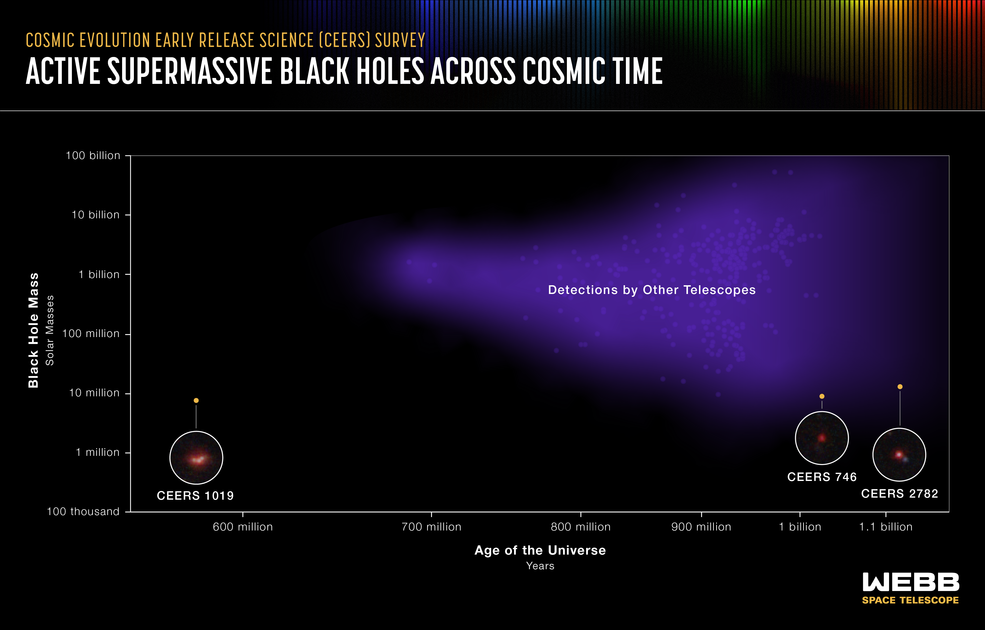
More Extremely Distant Black Holes, Galaxies Hit the Scene
The CEERS Survey is expansive, and there is a lot more to explore. Team member Dale Kocevski of Colby College in Waterville, Maine, and the team quickly spotted another pair of small black holes in the data. The first, within galaxy CEERS 2782, was easiest to pick out. There isn’t any dust obscuring Webb’s view of it, so researchers could immediately determine when its black hole existed in the history of the universe – only 1.1 billion years after the big bang. The second black hole, in galaxy CEERS 746, existed slightly earlier, 1 billion years after the big bang. Its bright accretion disk, a ring made up of gas and dust that encircles its supermassive black hole, is still partially clouded by dust. “The central black hole is visible, but the presence of dust suggests it might lie within a galaxy that is also furiously pumping out stars,” Kocevski explained.
Like the one in CEERS 1019, these two black holes are also “light weights” – at least when compared to previously known supermassive black holes at these distances. They are only about 10 million times the mass of the Sun. “Researchers have long known that there must be lower mass black holes in the early universe. Webb is the first observatory that can capture them so clearly,” Kocevski added. “Now we think that lower mass black holes might be all over the place, waiting to be discovered.” Before Webb, all three black holes were too faint to be detected. “With other telescopes, these targets look like ordinary star-forming galaxies, not active supermassive black holes,” Finkelstein added.
Webb’s sensitive spectra also allowed these researchers to measure precise distances to, and therefore the ages of, galaxies in the early universe. Team members Pablo Arrabal Haro of NSF's NOIRLab and Seiji Fujimoto of the University of Texas at Austin identified 11 galaxies that existed 470 to 675 million years after the big bang. Not only are they extremely distant, the fact that so many bright galaxies were detected is notable. Researchers theorized that Webb would detect fewer galaxies than are being found at these distances. “I am overwhelmed by the amount of highly detailed spectra of remote galaxies Webb returned,” Arrabal Haro said. “These data are absolutely incredible.”
These galaxies are rapidly forming stars, but are not yet as chemically enriched as galaxies that are much closer to home. “Webb was the first to detect some of these galaxies,” explained Fujimoto. “This set, along with other distant galaxies we may identify in the future, might change our understanding of star formation and galaxy evolution throughout cosmic history,” he added.
These are only the first groundbreaking findings from the CEERS survey. “Until now, research about objects in the early universe was largely theoretical,” Finkelstein said. “With Webb, not only can we see black holes and galaxies at extreme distances, we can now start to accurately measure them. That’s the tremendous power of this telescope.” In the future, it’s possible Webb’s data may also be used to explain how early black holes formed, revising researchers’ models of how black holes grew and evolved in the first several hundred million years of the universe’s history.
Several initial papers about CEERS Survey data have been accepted by The Astrophysical Journal Letters: “A CEERS Discovery of an Accreting Supermassive Black Hole 570 Myr after the Big Bang: Identifying a Progenitor of Massive z > 6 Quasars,” led by Larson, “Hidden Little Monsters: Spectroscopic Identification of Low-Mass, Broad-Line AGN at z > 5 with CEERS,” led by Kocevski, “Spectroscopic confirmation of CEERS NIRCam-selected galaxies at z≃8−10,” led by Arrabal Haro, and “CEERS Spectroscopic Confirmation of NIRCam-Selected z ≳ 8 Galaxy Candidates with JWST/NIRSpec: Initial Characterization of their Properties,” led by Fujimoto.
The James Webb Space Telescope is the world’s premier space science observatory. Webb will solve mysteries in our solar system, look beyond to distant worlds around other stars, and probe the mysterious structures and origins of our universe and our place in it. Webb is an international program led by NASA with its partners, ESA (European Space Agency) and the Canadian Space Agency.
Quelle: NASA
----
Update: 9.07.2023
.
Join NASA to Celebrate Webb Space Telescope’s First Year of Science
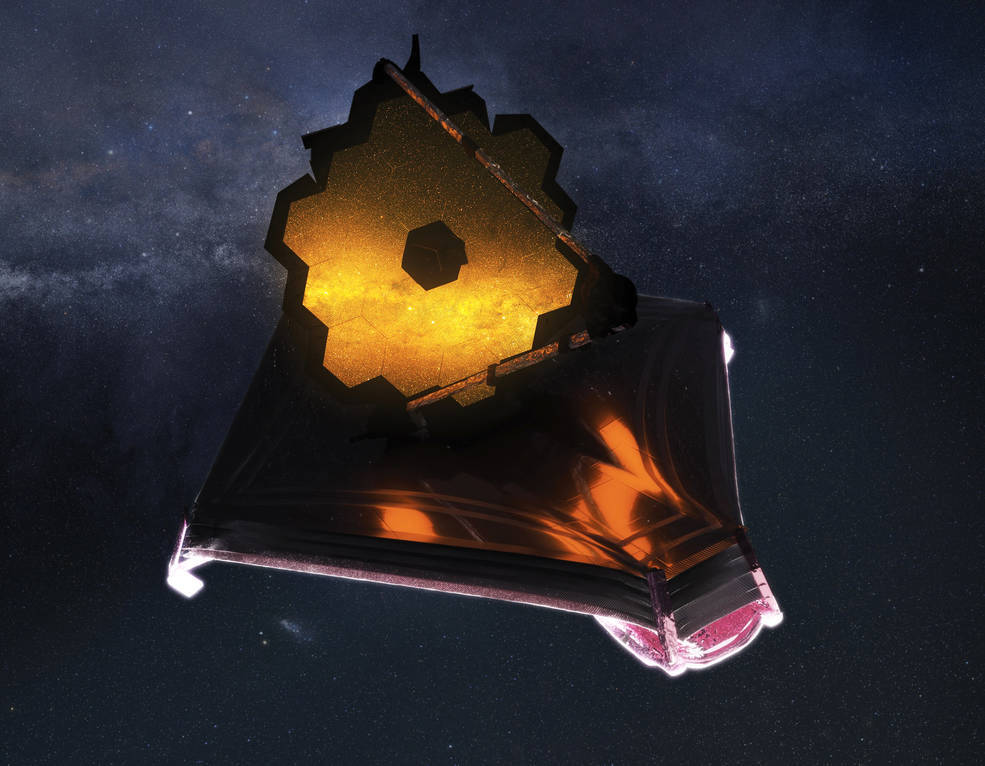
NASA is commemorating the first year of science and discoveries from the agency’s James Webb Space Telescope, the largest, most powerful, and most complex space telescope ever built. To celebrate the anniversary, multiple events will take place online and live across the U.S.
Webb’s first full-color images were released July 12, 2022, marking the beginning of the observatory’s science mission. Since then, Webb has discovered some of the earliest galaxies ever observed, delivered the most detailed view of the atmospheres of planets outside our solar system, and captured new views of planets within our solar system.
The schedule of Webb first anniversary events is as follows (all times are Eastern):
Wednesday, July 12
- 6 a.m.: Release of a new Webb image online
- 6 a.m.: Live interview opportunities begin
- Webb mission experts will be available to conduct live, remote interviews with broadcast media, in both English and Spanish. Details about scheduling these interviews are available online. Webb experts also are available for interviews outside of this window upon request.
- 4 p.m.: NASA Science Live online
- Two Webb experts will be featured on a NASA Science Live episode, discussing how Webb has made an impact in its first year on exploring the distant universe, characterizing exoplanet atmospheres, and understanding the solar system. The show will air live on the NASA Science Live website, as well as YouTube, Facebook, and Twitter. Viewers of this episode can submit questions on social media using the hashtag #UnfoldtheUniverse or by leaving a comment in the chat section of the Facebook or YouTube stream.
Friday, July 14
- 1 p.m.: Webb anniversary event, Enoch Pratt Free Library in Baltimore
- Visitors of all ages can learn about the telescope and how it studies the universe with its infrared eyes. There will be talks about Webb, a Virtual Reality experience, hands-on activities for children, and educational giveaway items.
This Summer:
- Webb anniversary community events, nationwide
- Throughout the summer, locations around the country are hosting Webb Community Events to celebrate Webb’s anniversary. These free, public events will be held at schools, libraries, museums, and other community locations in 25 states and Washington, in July, August, and September. Each event will be different, and all will highlight Webb’s science and accomplishments with information, activities, or a presentation.
The James Webb Space Telescope is the world’s premier space science observatory. Webb is solving mysteries in our solar system, looking beyond to distant worlds around other stars, and probing the mysterious structures and origins of our universe and our place in it. Webb is an international program led by NASA with its partners, ESA (European Space Agency), and CSA (Canadian Space Agency).
Quelle: NASA
----
Update: 12.07.2023
.
New 3D Visualization Highlights 5,000 Galaxies Revealed by Webb
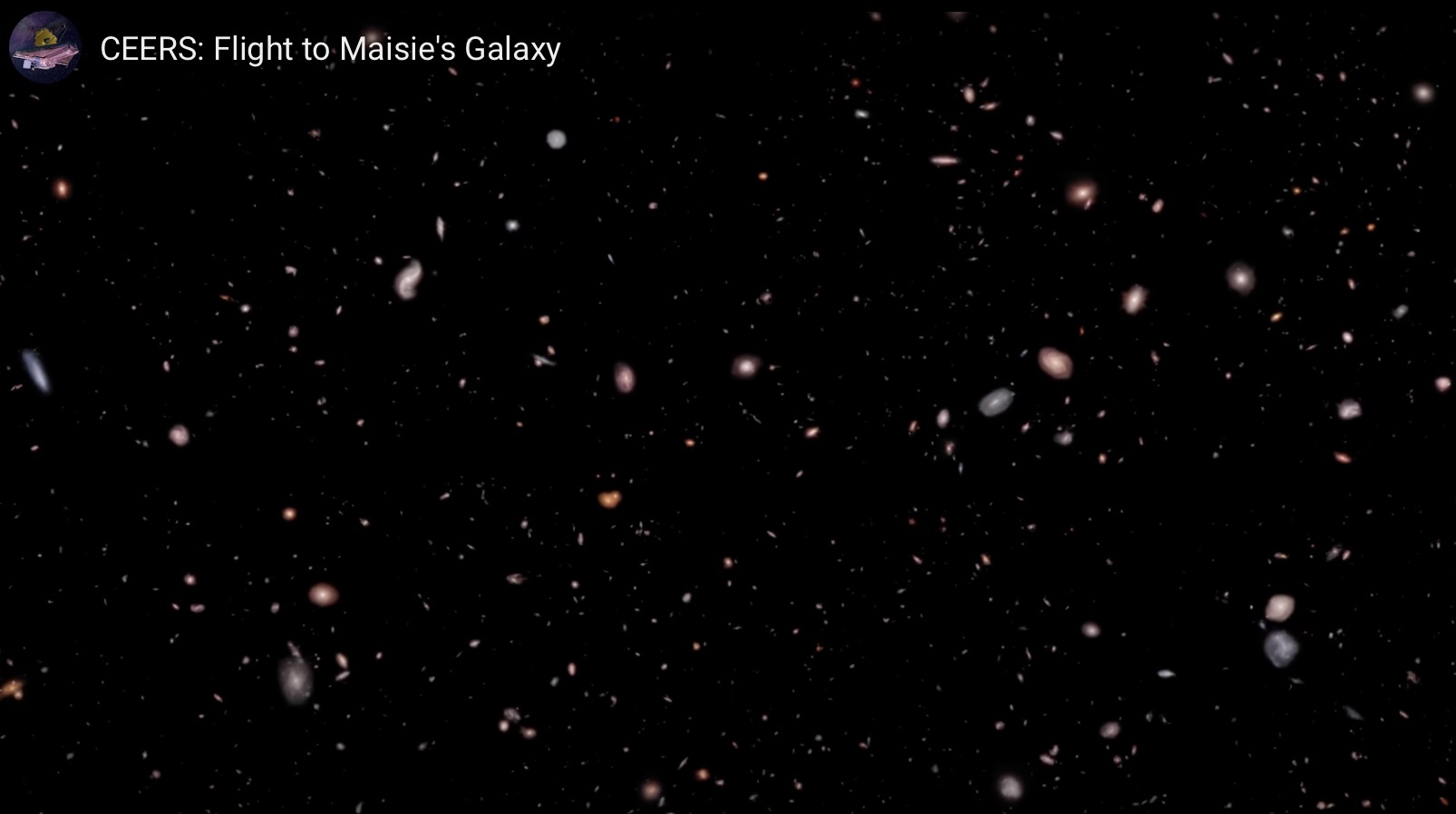
This video, a scientific visualization of the galaxies captured as a part of the CEERS (Cosmic Evolution Early Release Science) Survey, showcases a large undertaking by NASA’s James Webb Space Telescope. It flies by thousands of galaxies, starting with those nearby and ending with less-developed galaxies in the very distant universe, including one never seen before Webb.
The area highlighted in this visualization is a small part of the Extended Groth Strip, a region between the Ursa Major and Boötes constellations originally observed by the Hubble Space Telescope between 2004 and 2005. While this vast region contains about 100,000 galaxies, the visualization focuses on approximately 5,000 – with the nearest and more complex galaxies, shown in the beginning, located within a few billion light-years of Earth. As the visualization proceeds, showing galaxies farther away from Earth, we see different stages of the universe’s history and evolution.
The visualization’s farthest galaxy, known as Maisie’s Galaxy, is a target of great interest to astronomers. It formed about 390 million years after the big bang, or about 13.4 billion years ago. It’s not only one of the first bright, extremely distant galaxies found by Webb, but it’s also an example of an early galaxy that only Webb could see. This is because Webb’s instruments can capture the light from these early galaxies, which has been shifted to infrared wavelengths by the expansion of the universe.
“This observatory just opens up this entire period of time for us to study,” said Rebecca Larson of the Rochester Institute of Technology in Rochester, New York, one of the survey’s investigators. “We couldn’t study galaxies like Maisie’s before because we couldn’t see them. Now, not only are we able to find them in our images, we’re able to find out what they’re made of and if they differ from the galaxies that we see close by.”
Steven Finkelstein of the University of Texas at Austin, principal investigator of the CEERS program, continued, “This observation exceeded our expectations. The sheer number of galaxies that we’re finding in the early universe is at the upper end of all predictions.” The observatory’s ability to conduct surveys like these provides a demonstration of Webb’s instruments for astronomers to reference for future observations.
This visualization not only shows just how far Webb can observe, but also how much it builds off the accomplishments of Hubble. In many cases, Hubble’s observations, along with Webb’s data from the CEERS Survey, enabled researchers to determine which galaxies were truly far away – the early-universe galaxies of interest – and which were nearby, but so dusty that their visible light was obscured.
With these observations, the next goal for researchers is to learn about the formation of stars in these early galaxies.
“We’re used to thinking of galaxies as smoothly growing,” Finkelstein remarked. “But maybe these stars are forming like firecrackers. Are these galaxies forming more stars than expected? Are the stars they’re making more massive than we expect? These data have given us the information to ask these questions. Now, we need more data to get those answers.”
The James Webb Space Telescope is the world's premier space science observatory. Webb is solving mysteries in our solar system, looking beyond to distant worlds around other stars, and probing the mysterious structures and origins of our universe and our place in it. Webb is an international program led by NASA with its partners, ESA (European Space Agency) and the Canadian Space Agency.
Webb Celebrates First Year of Science With Close-up on Birth of Sun-like Stars
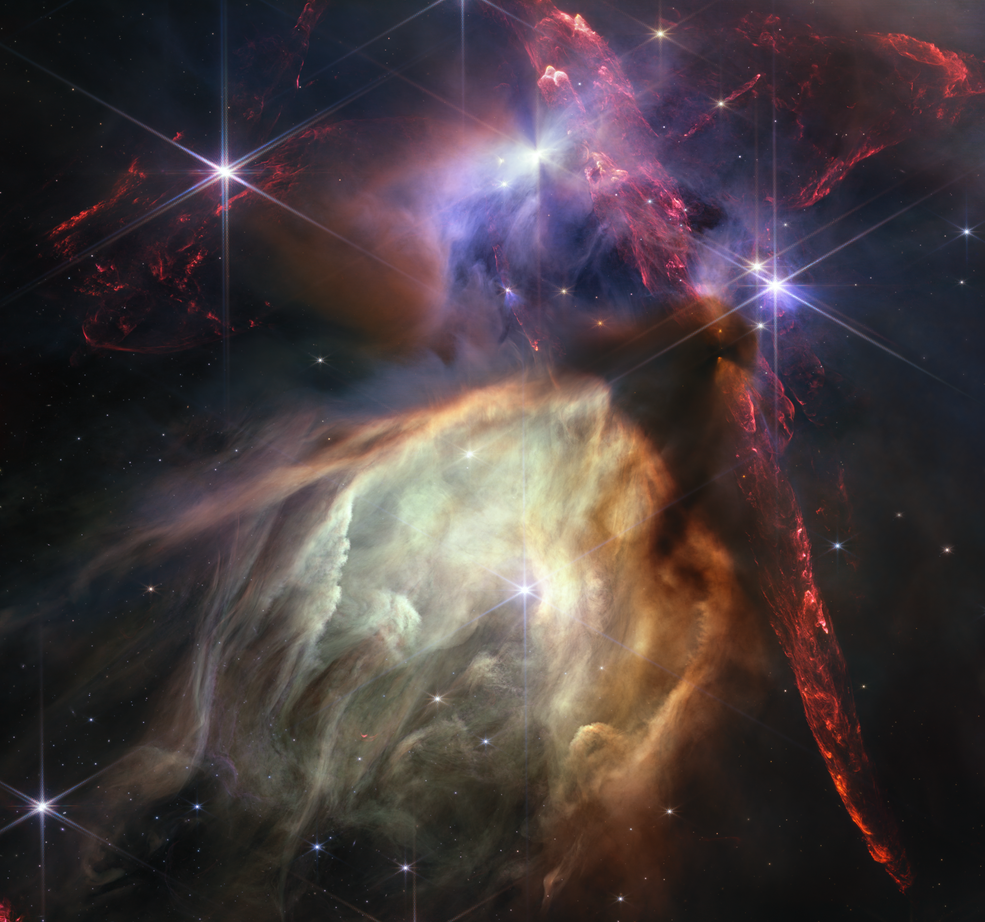
From our cosmic backyard in the solar system to distant galaxies near the dawn of time, NASA’s James Webb Space Telescope has delivered on its promise of revealing the universe like never before in its first year of science operations. To celebrate the completion of a successful first year, NASA has released Webb’s image of a small star-forming region in the Rho Ophiuchi cloud complex.
“In just one year, the James Webb Space Telescope has transformed humanity’s view of the cosmos, peering into dust clouds and seeing light from faraway corners of the universe for the very first time. Every new image is a new discovery, empowering scientists around the globe to ask and answer questions they once could never dream of,” said NASA Administrator Bill Nelson. “Webb is an investment in American innovation but also a scientific feat made possible with NASA’s international partners that share a can-do spirit to push the boundaries of what is known to be possible. Thousands of engineers, scientists, and leaders poured their life’s passion into this mission, and their efforts will continue to improve our understanding of the origins of the universe – and our place in it.”
The new Webb image released today features the nearest star-forming region to us. Its proximity at 390 light-years allows for a highly detailed close-up, with no foreground stars in the intervening space.
“On its first anniversary, the James Webb Space Telescope has already delivered upon its promise to unfold the universe, gifting humanity with a breathtaking treasure trove of images and science that will last for decades,” said Nicola Fox, associate administrator of NASA’s Science Mission Directorate in Washington. “An engineering marvel built by the world’s leading scientists and engineers, Webb has given us a more intricate understanding of galaxies, stars, and the atmospheres of planets outside of our solar system than ever before, laying the groundwork for NASA to lead the world in a new era of scientific discovery and the search for habitable worlds.”
Webb’s image shows a region containing approximately 50 young stars, all of them similar in mass to the Sun, or smaller. The darkest areas are the densest, where thick dust cocoons still-forming protostars. Huge bipolar jets of molecular hydrogen, represented in red, dominate the image, appearing horizontally across the upper third and vertically on the right. These occur when a star first bursts through its natal envelope of cosmic dust, shooting out a pair of opposing jets into space like a newborn first stretching her arms out into the world. In contrast, the star S1 has carved out a glowing cave of dust in the lower half of the image. It is the only star in the image that is significantly more massive than the Sun.
“Webb’s image of Rho Ophiuchi allows us to witness a very brief period in the stellar lifecycle with new clarity. Our own Sun experienced a phase like this, long ago, and now we have the technology to see the beginning of another’s star’s story,” said Klaus Pontoppidan, who served as Webb project scientist at the Space Telescope Science Institute in Baltimore, Maryland, since before the telescope’s launch and through the first year of operations.
Some stars in the image display tell-tale shadows indicating protoplanetary disks – potential future planetary systems in the making.
A Full Year, Across the Full Sky
From its very first deep field image, unveiled by President Joe Biden, Vice President Kamala Harris, and Nelson live at the White House, Webb has delivered on its promise to show us more of the universe than ever before. However, Webb revealed much more than distant galaxies in the early universe.
“The breadth of science Webb is capable of exploring really becomes clear now, when we have a full year’s worth of data from targets across the sky,” said Eric Smith, associate director for research in the Astrophysics Division at NASA Headquarters and Webb program scientist. “Webb’s first year of science has not only taught us new things about our universe, but it has revealed the capabilities of the telescope to be greater than our expectations, meaning future discoveries will be even more amazing.” The global astronomy community has spent the past year excitedly poring over Webb’s initial public data and getting a feel for how to work with it.
Beyond the stunning infrared images, what really has scientists excited are Webb’s crisp spectra – the detailed information that can be gleaned from light by the telescope’s spectroscopic instruments. Webb’s spectra have confirmed the distances of some of the farthest galaxies ever observed, and have discovered the earliest, most distant supermassive black holes. They have identified the compositions of planet atmospheres (or lack thereof) with more detail than ever before, and have narrowed down what kinds of atmospheres may exist on rocky exoplanets for the first time. They also have revealed the chemical makeup of stellar nurseries and protoplanetary disks, detecting water, organic carbon-containing molecules, and more. Already, Webb observations have resulted in hundreds of scientific papers answering longstanding questions and raising new ones to address with Webb.
The breadth of Webb science is also apparent in its observations of the region of space we are most familiar with – our own solar system. Faint rings of gas giants appear out of the darkness, dotted by moons, while in the background Webb shows distant galaxies. By comparing detections of water and other molecules in our solar system with those found in the disks of other, much younger planetary systems, Webb is helping to build up clues about our own origins – how Earth became the ideal place for life as we know it.
"With a year of science under our belts, we know exactly how powerful this telescope is, and have delivered a year of spectacular data and discoveries,” said Webb Senior Project Scientist Jane Rigby of NASA's Goddard Space Flight Center. “We've selected an ambitious set of observations for year two — that builds on everything we've learned so far. Webb's science mission is just getting started — there's so much more to come."
Quelle: NASA
----
Update: 18.07.2023
.
Webb Telescope catches glimpse of possible first-ever 'dark stars'
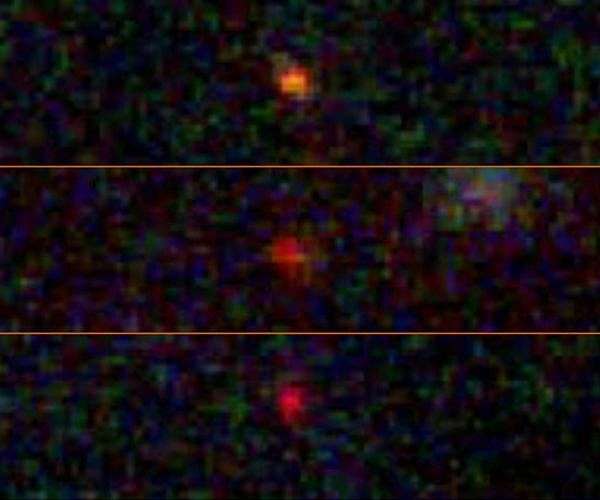
These three objects (JADES-GS-z13-0, JADES-GS-z12-0, and JADES-GS-z11-0) were originally identified as galaxies in December 2022 by the JWST Advanced Deep Extragalactic Survey (JADES). Now, a team including Katherine Freese at The University of Texas at Austin speculate they might actually be "dark stars," theoretical objects much bigger and brighter than our sun, powered by particles of dark matter annihilating.
Austin TX (SPX) Jul 14, 2023 Stars beam brightly out of the darkness of space thanks to fusion, atoms melding together and releasing energy. But what if there's another way to power a star?
A team of three astrophysicists - Katherine Freese at The University of Texas at Austin, in collaboration with Cosmin Ilie and Jillian Paulin '23 at Colgate University - analyzed images from the James Webb Space Telescope (JWST) and found three bright objects that might be "dark stars," theoretical objects much bigger and brighter than our sun, powered by particles of dark matter annihilating. If confirmed, dark stars could reveal the nature of dark matter, one of the deepest unsolved problems in all of physics.
"Discovering a new type of star is pretty interesting all by itself, but discovering it's dark matter that's powering this-that would be huge," said Freese, director of the Weinberg Institute for Theoretical Physics and the Jeff and Gail Kodosky Endowed Chair in Physics at UT Austin.
Although dark matter makes up about 25% of the universe, its nature has eluded scientists. Scientists believe it consists of a new type of elementary particle, and the hunt to detect such particles is on. Among the leading candidates are Weakly Interacting Massive Particles. When they collide, these particles annihilate themselves, depositing heat into collapsing clouds of hydrogen and converting them into brightly shining dark stars. The identification of supermassive dark stars would open up the possibility of learning about the dark matter based on their observed properties.
The research is published in the Proceedings of the National Academy of Sciences.
Follow-up observations from JWST of the objects' spectroscopic properties - including dips or excess of light intensity in certain frequency bands - could help confirm whether these candidate objects are indeed dark stars.
Confirming the existence of dark stars might also help solve a problem created by JWST: There seem to be too many large galaxies too early in the universe to fit the predictions of the standard model of cosmology.
"It's more likely that something within the standard model needs tuning, because proposing something entirely new, as we did, is always less probable," Freese said. "But if some of these objects that look like early galaxies are actually dark stars, the simulations of galaxy formation agree better with observations."
The three candidate dark stars (JADES-GS-z13-0, JADES-GS-z12-0, and JADES-GS-z11-0) were originally identified as galaxies in December 2022 by the JWST Advanced Deep Extragalactic Survey (JADES). Using spectroscopic analysis, the JADES team confirmed the objects were observed at times ranging from about 320 million to 400 million years after the Big Bang, making them some of the earliest objects ever seen.
"When we look at the James Webb data, there are two competing possibilities for these objects," Freese said. "One is that they are galaxies containing millions of ordinary, population-III stars. The other is that they are dark stars. And believe it or not, one dark star has enough light to compete with an entire galaxy of stars."
Dark stars could theoretically grow to be several million times the mass of our sun and up to 10 billion times as bright as the sun.
"We predicted back in 2012 that supermassive dark stars could be observed with JWST," said Ilie, assistant professor of physics and astronomy at Colgate University. "As shown in our recently published PNAS article, we already found three supermassive dark star candidates when analyzing the JWST data for the four high redshift JADES objects spectroscopically confirmed by Curtis-Lake et al, and I am confident we will soon identify many more."
The idea for dark stars originated in a series of conversations between Freese and Doug Spolyar, at the time a graduate student at the University of California, Santa Cruz. They wondered: What does dark matter do to the first stars to form in the universe? Then they reached out to Paolo Gondolo, an astrophysicist at the University of Utah, who joined the team. After several years of development, they published their first paper on this theory in the journal Physical Review Letters in 2008.
Together, Freese, Spolyar and Gondolo developed a model that goes something like this: At the centers of early protogalaxies, there would be very dense clumps of dark matter, along with clouds of hydrogen and helium gas. As the gas cooled, it would collapse and pull in dark matter along with it. As the density increased, the dark matter particles would increasingly annihilate, adding more and more heat, which would prevent the gas from collapsing all the way down to a dense enough core to support fusion as in an ordinary star. Instead, it would continue to gather more gas and dark matter, becoming big, puffy and much brighter than ordinary stars. Unlike ordinary stars, the power source would be evenly spread out, rather than concentrated in the core. With enough dark matter, dark stars could grow to be several million times the mass of our sun and up to 10 billion times as bright as the sun.
Funding for this research was provided by the U.S. Department of Energy's Office of High Energy Physics program and the Vetenskapsradet (Swedish Research Council) at the Oskar Klein Centre for Cosmoparticle Physics at Stockholm University.
Quelle: SD
----
Update: 19.07.2023
.
JWST finds ‘smoking gun’ evidence of early galaxies transforming the universe
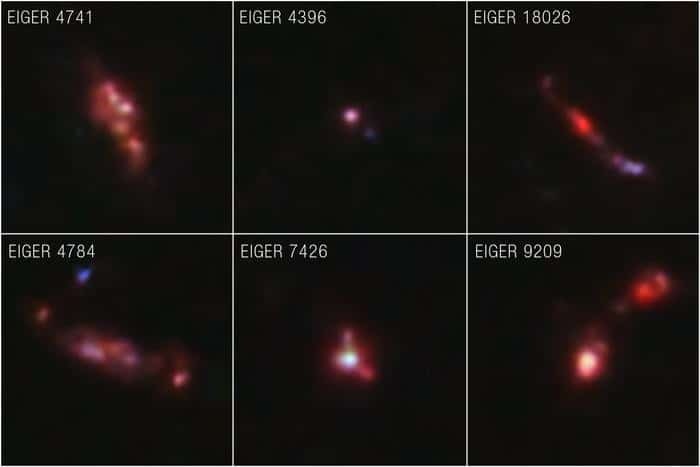
Time machine: detailed near-infrared images of galaxies that existed when the universe was only 900 million years old. The images were taken by the JWST as part of a study of reionization in the early universe. Courtesy: NASA, ESA, CSA, Simon Lilly (ETH Zurich), Daichi Kashino (Nagoya University), Jorryt Matthee (ETH Zurich), Christina Eilers (MIT), Rob Simcoe (MIT), Rongmon Bordoloi (NCSU), Ruari Mackenzie (ETH Zurich); Image Processing: Alyssa Pagan (STScI), Ruari Macke)
Using the James Webb Space Telescope (JWST), an international team of astronomers has found compelling evidence that early galaxies were responsible for the reionization of the early universe. This is the process by which neutral hydrogen atoms are ionized, making the universe transparent to light at wavelengths that would have been absorbed by the atoms. The research was done by members of the EIGER collaboration, which is using the JWST’s Near Infrared Camera (NIRCam) to study light from quasars in the early universe.
The cosmological era of reionization occurred around a billion years after the Big Bang. Prior to reionization, neutral hydrogen gas between early galaxies absorbed light at certain wavelengths. Then something caused the cosmos to heat up, ionizing the gas to create a plasma. These regions of plasma were less efficient at absorbing light, creating “bubbles” of transparency in the universe.
These bubbles were much larger than the galaxies themselves, with diameters of about 4 million light–years across. Over the hundred million years or so, the bubbles grew and joined together, and eventually the entire universe became transparent. However, exactly what caused this reionization is an important cosmological mystery.
Default explanation
“It was presumably some source of ionizing radiation,” team leader Simon Lilly tell Physics World. “It’s fair to say the default explanation was always that it was ultraviolet light from the first stars and galaxies that formed early in the universe,” explains Lilly, who is based at ETH Zurich in Switzerland. “Some of those stars will be hot enough that they produce a lot of ultraviolet photons, and in principle, that could do it.”
Other sources of ionizing radiation have also been suggested. These include the generation of ultraviolet radiation and X-rays by the acceleration of material as it falls into black holes.
Now, Lilly and colleagues have studied reionization by using the JWST to observe light from an ancient quasar. This is a supermassive black hole that swallows large amounts of material, causing the emission of huge amounts of radiation. By studying how this light passed through ancient galaxies on its way to Earth, the team discovered a correlation between the locations of these galaxies and the locations of patches of reionized gas. This allowed the researchers to conclude that something within these galaxies, possibly young stars, ionized the surrounding space.
This is the smoking gun, that it was galaxies that did the reionization
Simon Lilly
Lilly together with Daichi Kashino at Japan’s Nagoya University and colleagues describe their findings in a paper in The Astrophysical Journal. This paper is one of three published in that journal related to this research. The second paper is by ETH Zurich scientist Jorryt Mattheeand colleagues and looks at the properties of the galaxies, and the third paper looks at the quasar itself and is by Anna-Christina Eilers at the Massachusetts Institute of Technology.
The team will now investigate five other quasars and their lines of sight to Earth in order to further explore the connection between galaxies and reionization.
“We’re not the first to discover galaxies at these epochs, and indeed, the JWST is finding galaxies at significantly earlier epochs, but what the telescope really enabled was for us to produce very large, homogeneous samples of galaxies,” Lilly said. “I would have no hesitation in saying we couldn’t have done this without the JWST.”
For Lilly, who has been associated with the telescope since its early planning stages in the 1990s, this result is an important validation that the JWST is useful beyond taking incredible images of the universe; it has real experimental value too.
“We’re seeing the universe as it was a few 100 million years after the Big Bang, and we’re doing physics there,” Lilly concluded. “We are actually answering questions with the JWST, not just standing in awe of the majesty of the universe.”
Quelle: physicsworld
----
Update: 21.07.2023
.
Webb sees carbon-rich dust grains in the first billion years of cosmic time
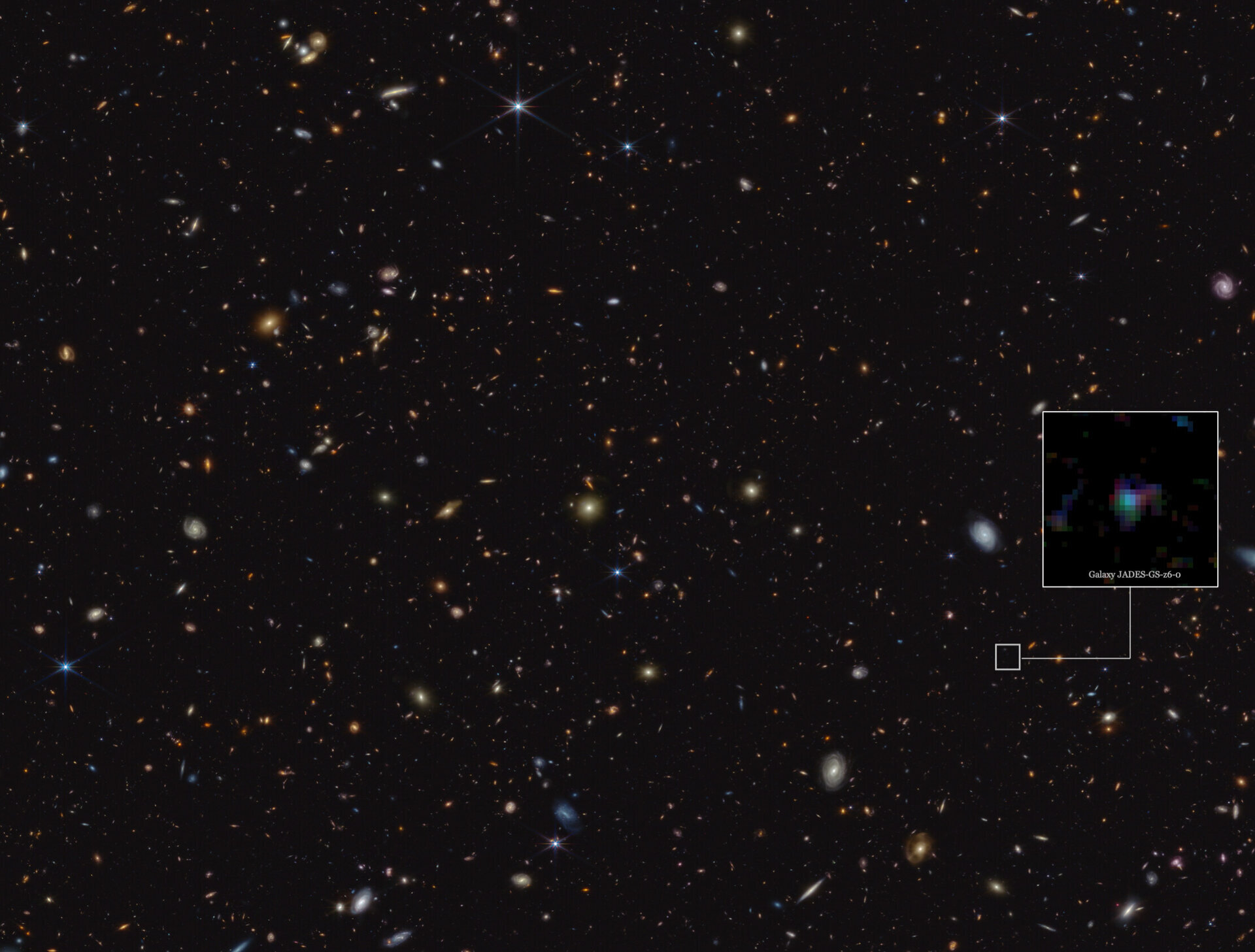
For the first time, the NASA/ESA/CSA James Webb Space Telescope has observed the chemical signature of carbon-rich dust grains at redshift ~ 7 [1], which is roughly equivalent to one billion years after the birth of the Universe [2]. Similar observational signatures have been observed in the much more recent Universe, attributed to complex, carbon-based molecules known as polycyclic aromatic hydrocarbons (PAHs). It is not thought likely, however, that PAHs would have developed within the first billion years of cosmic time.
Therefore, this observation suggests the exciting possibility that Webb may have observed a different species of carbon-based molecule: possibly minuscule graphite- or diamond-like grains produced by the earliest stars or supernovae. This observation suggests exciting avenues of investigation into both the production of cosmic dust and the earliest stellar populations in our Universe, and was made possible by Webb’s unprecedented sensitivity.
The seemingly empty spaces in our Universe are in reality often not empty at all, but occupied by clouds of gas and cosmic dust. This dust consists of grains of various sizes and compositions that are formed and ejected into space in a variety of ways, including by supernova events. This material is crucial to the evolution of the Universe, as dust clouds ultimately form the birthplaces for new stars and planets. However, it can also be a hindrance to astronomers: the dust absorbs stellar light at certain wavelengths, making some regions of space very challenging to observe. An upside, however, is that certain molecules will very consistently absorb or otherwise interact with specific wavelengths of light. This means that astronomers can acquire information about the cosmic dust’s composition by observing the wavelengths of light that it blocks. An international team of astronomers used this technique, combined with Webb’s extraordinary sensitivity, to detect the presence of carbon-rich dust grains only a billion years after the birth of the Universe.
Joris Witstok of the University of Cambridge, the lead author of this work, elaborates: “Carbon-rich dust grains can be particularly efficient at absorbing ultraviolet light with a wavelength around 217.5 nanometres, which for the first time we have directly observed in the spectra of very early galaxies.”
This prominent 217.5-nanometre feature has previously been observed in the much more recent and local Universe, both within our own Milky Way galaxy, and in galaxies up to redshift ~ 3 [1]. It has been attributed to two different types of carbon-based species: polycyclic aromatic hydrocarbons (PAHs) or nano-sized graphitic grains. PAHs are complex molecules, and modern models predict that it should take several hundreds of millions of years before they form. It would be surprising, therefore, if the team had observed the chemical signature of a mixture of dust grains that include species that were unlikely to have formed yet. However, according to the science team, this result is the earliest and most distant direct signature for this particular type of carbon-rich dust grain.
The answer may lie in the details of what was observed. As already stated, the feature associated with the cosmic dust mixture of PAHs and tiny graphitic grains is at 217.5 nanometres. However, the feature observed by the team actually peaked at 226.3 nanometres. A nanometre is a millionth of a millimetre, and this discrepancy of less than ten nanometres could be accounted for by measurement error [3]. Equally, it could also indicate a difference in the composition of the early-Universe cosmic dust mixture that the team detected.
“This slight shift in wavelength of where the absorption is strongest suggests we may be seeing a different mix of grains, for example graphite- or diamond-like grains,” adds Witstok. “This could also potentially be produced on short timescales by Wolf-Rayet stars or supernova ejecta.”
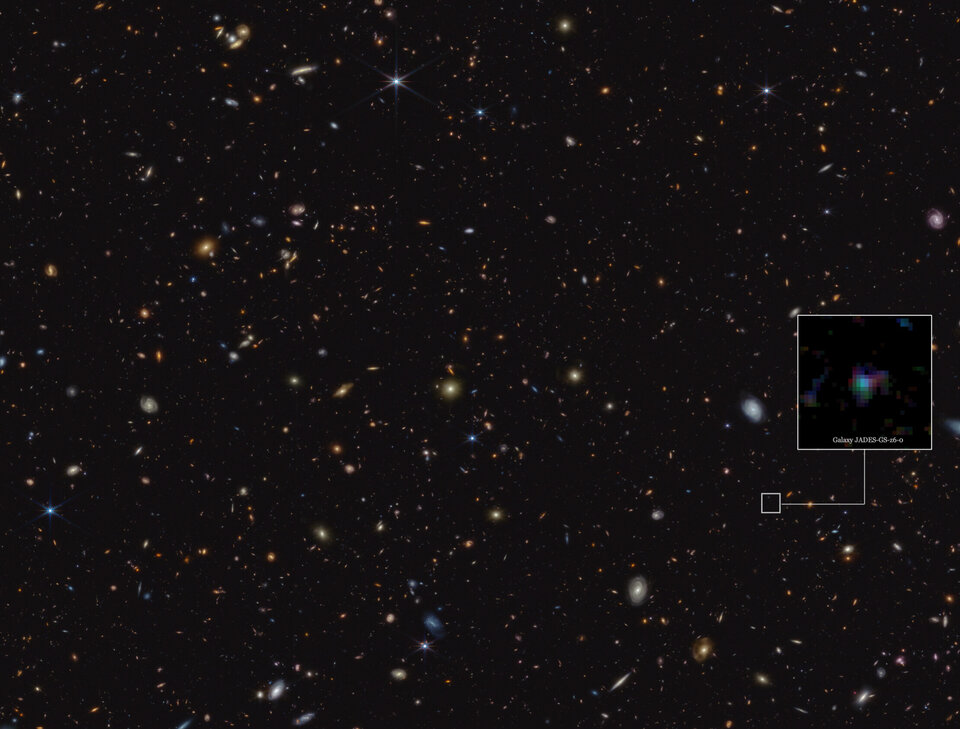
The detection of this feature in the early Universe is surprising, and allows astronomers to postulate about the mechanisms that could create such a mix of dust grains. This involves drawing on existing knowledge from observations and models. Witstok suggests diamond grains formed in supernova ejecta because models have previously suggested that nano-diamonds could be formed this way. Wolf-Rayet stars are suggested because they are exceptionally hot towards the end of their lives, and very hot stars tend to live fast and die young; giving enough time for generations of stars to have been born, lived, and died, to distribute carbon-rich grains into the surrounding cosmic dust in under a billion years. Models have also shown that carbon-rich grains can be produced by certain types of Wolf-Rayet stars, and just as importantly that those grains can survive the violent deaths of those stars. However, it is still a challenge to fully explain these results with the existing understanding of the early formation of cosmic dust. These results will therefore go on to inform the development of improved models and future observations.
Before Webb, the observations of multiple galaxies had to be combined in order to get signals strong enough to make deductions about the stellar populations in the galaxies, and to learn about how their light was affected by dust absorption. Importantly, astronomers were restricted to studying relatively old and mature galaxies that had had a long time to form stars as well as dust. This limited their ability to really pin down the key sources of cosmic dust. With the advent of Webb, astronomers are now able to make very detailed observations of the light from individual dwarf galaxies, seen in the first billion years of cosmic time. Webb finally permits the study of the origin of cosmic dust and its role in the crucial first stages of galaxy evolution.
“This discovery was made possible by the unparalleled sensitivity improvement in near-infrared spectroscopy provided by Webb, and specifically its Near-Infrared Spectrograph (NIRSpec),” noted team member Roberto Maiolino of the University of Cambridge and University College London. “The increase in sensitivity provided by Webb is equivalent, in the visible, to instantaneously upgrading Galileo’s 37-millimetre telescope to the 8-metre Very Large Telescope (one of the most powerful modern optical telescopes).”
NIRSpec was built for the European Space Agency by a consortium of European companies led by Airbus Defence and Space (ADS) with NASA’s Goddard Space Flight Centre providing its detector and micro-shutter subsystems. The primary goal of NIRSpec is to enable large spectroscopic surveys of astronomical objects such as stars or distant galaxies. This is made possible by its powerful multi-object spectroscopy mode, which makes use of microshutters. This mode is capable of obtaining spectra of up to nearly 200 objects simultaneously, over a 3.6 × 3.4 arcminute field of view — the first time this capability has been provided from space. This mode makes for very efficient use of Webb’s valuable observing time.
The team is also planning further research into the data and this result. “We are planning to work further with theorists who model dust production and growth in galaxies,” shares team member Irene Shivaei of the University of Arizona/Centro de Astrobiología (CAB). “This will shed light on the origin of dust and heavy elements in the early Universe.”
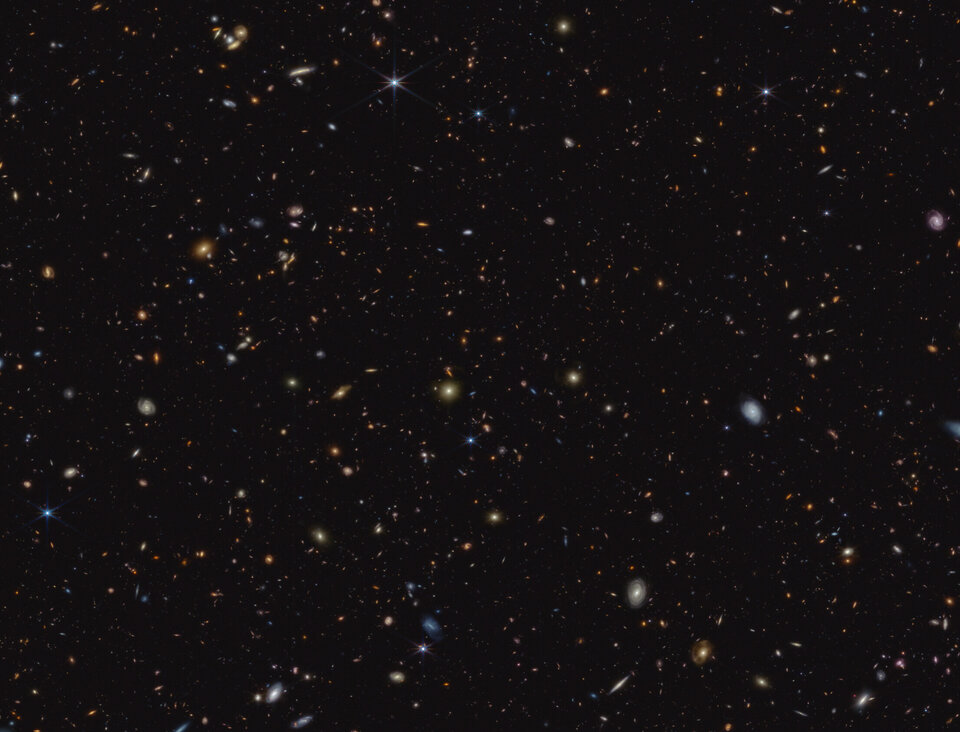
These observations were made as part of the JWST Advanced Deep Extragalactic Survey, or JADES, which devoted about 32 days of telescope time to uncovering and characterising faint, distant galaxies. This programme has facilitated the discovery of hundreds of galaxies that existed when the Universe was less than 600 million years old, including some of the farthest galaxies known to date. The sheer number and maturity of these galaxies was far beyond predictions from observations made before Webb’s launch. This new result of early-Universe dust grains contributes to our growing and evolving understanding of the evolution of stellar populations and galaxies during the first billion years of cosmic time.
“This discovery implies that infant galaxies in the early Universe develop much faster than we ever anticipated," adds team member Renske Smit of the Liverpool John Moores University in the United Kingdom. “Webb shows us a complexity of the earliest birth-places of stars (and planets) that models are yet to explain.“
The results have been published today in Nature.
Quelle: ESA


